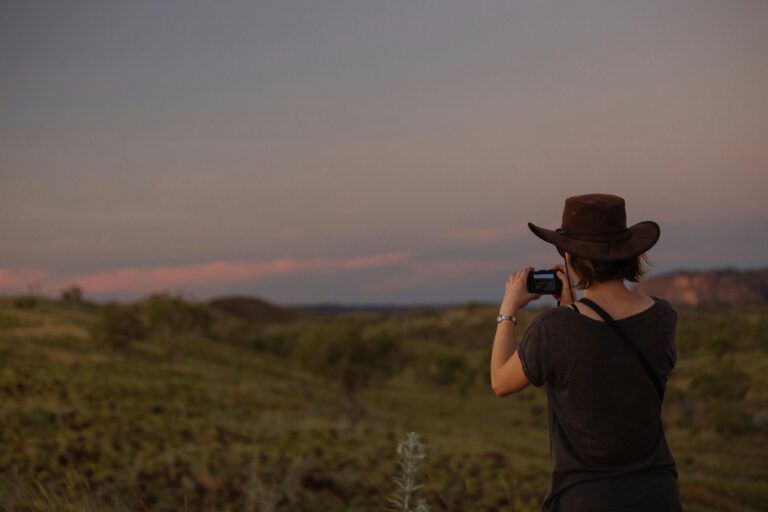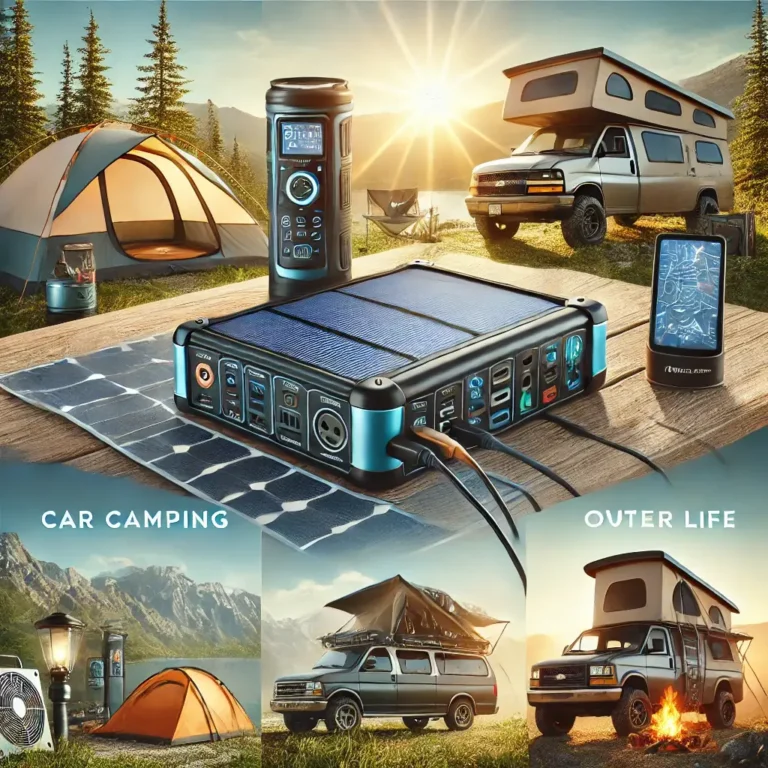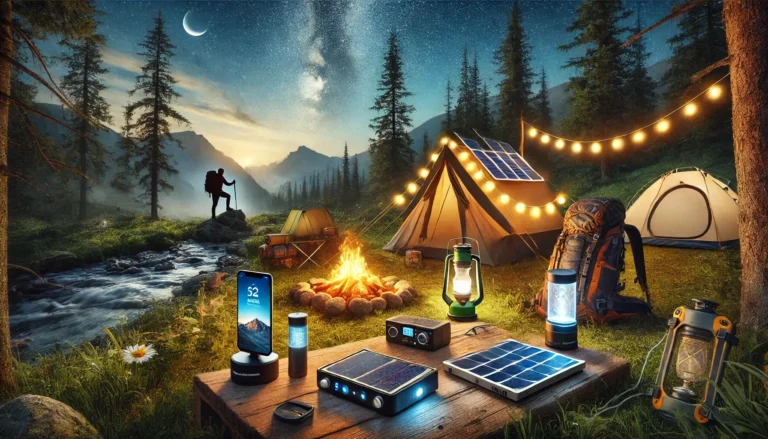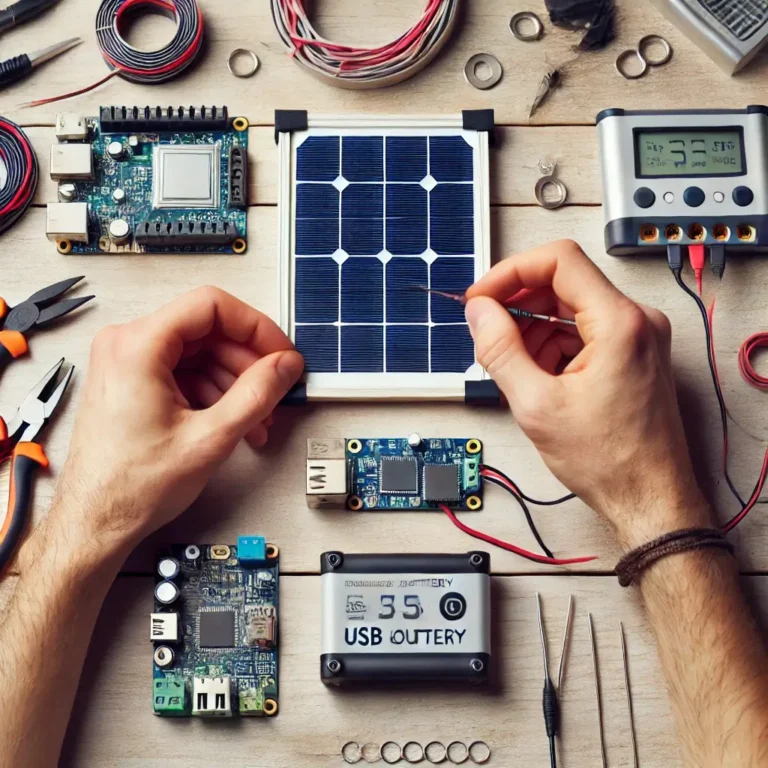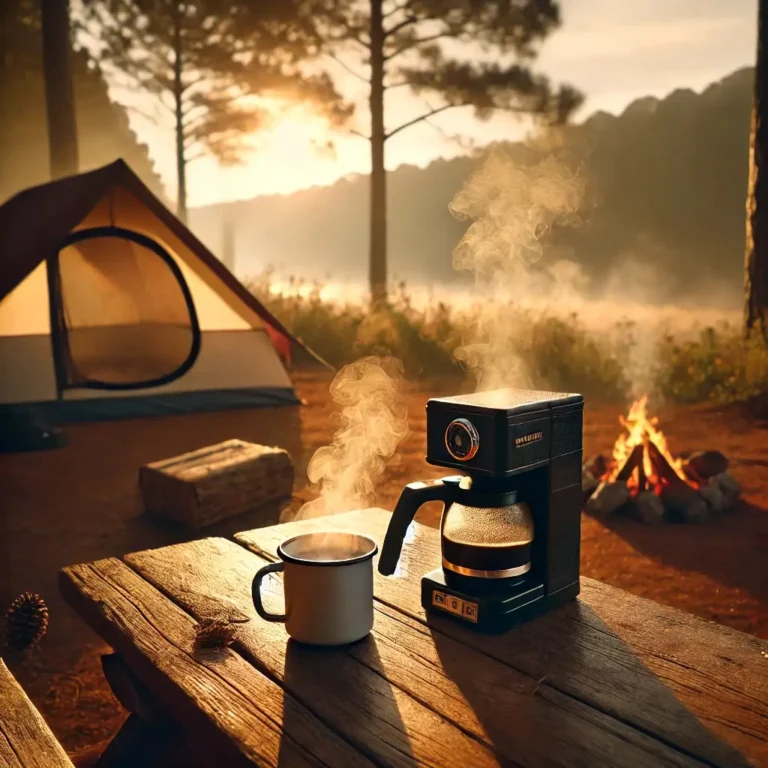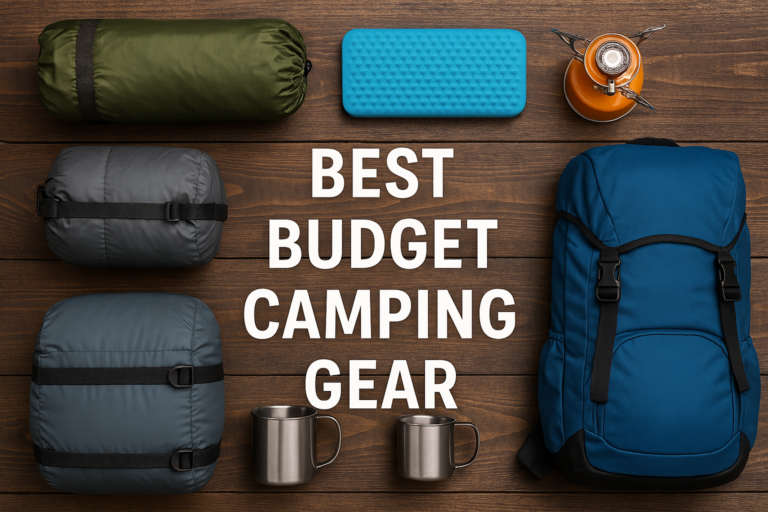Camping GPS for Beginners: Ultimate Navigation Guide.
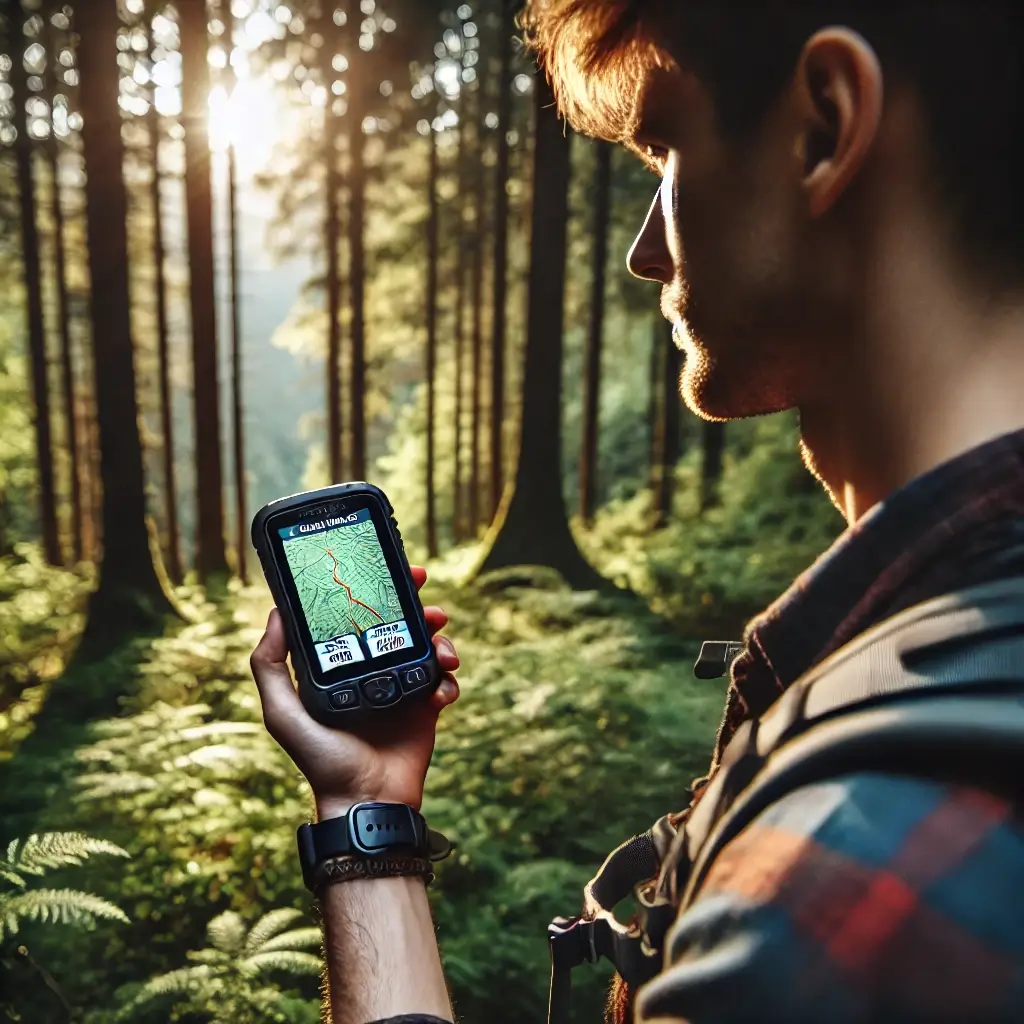
Introduction
Did you know that over 40% of first-time hikers report feeling anxious about getting lost in unfamiliar terrain (National Park Service) ? I’ve been there too! When I first started exploring the great outdoors, a reliable camping GPS for beginners became my most treasured piece of gear. Today’s camping GPS technology has evolved dramatically, making it easier than ever for beginners to navigate confidently in the wilderness. Whether you’re planning weekend camping trips or longer backcountry adventures, understanding how to choose and use a camping GPS for beginners can transform your outdoor experience from stressful to spectacular!
👉 Check out our complete guide to outdoor navigation (Pillar Post)
Why Camping GPS for Beginners Is Essential for Outdoor Safety
My first hiking trip was a disaster. I got lost with three friends on an “easy” Adirondack trail. We took a wrong turn. The landmarks didn’t match our paper map. Dark clouds rolled in. We panicked.
That day taught me why GPS devices aren’t just fancy gadgets. They’re lifesavers for new campers.
What is a camping GPS for beginners? It’s your personal wilderness guide. Unlike your phone, which loses signal in remote areas, a handheld GPS works almost anywhere under open sky. These devices get signals directly from satellites.
I resisted buying one at first. “Maps worked for centuries,” I told myself. But after getting lost as storm clouds gathered? I went straight to the store and bought an affordable hiking GPS the next day.
The difference was amazing. No more guessing at trail forks. I could see exactly where I was on the digital map. The basic GPS functions are actually easy to use once you try them.
I was surprised by how well GPS works in forests. While not perfect under thick trees, good camping GPS for beginners perform much better than I expected. My unit kept satellite reception even under a thick tree canopy.
Battery life worried me at first. What good is a device that dies when you need it most? But modern camping GPS for beginners last 15-20 hours on one charge. I still pack spare batteries just to be safe.
Learning about waypoints changed everything for me. Before each trip, I mark key spots—trailhead, campsite, water sources, and exit routes. This simple step saved me when fog rolled in during a trip last summer. I couldn’t see far ahead, but my GPS led me straight back to camp.
Camping GPS for Beginners: Key Features to Prioritize in Your First Device
When I bought my first camping GPS for beginners, I was completely overwhelmed. The salesperson kept talking about features I’d never heard of. I ended up with an expensive device that was way too complicated for my needs.
Don’t make my mistake! After five years of using various outdoor navigation tools for novices, I’ve learned which features actually matter for beginners.
Battery life is probably the most important feature. My first GPS died after just 8 hours on the trail. Talk about scary! Now I only buy hiking GPS units with at least 20 hours of battery life. Some newer models have rechargeable options, which save money long-term.
Screen visibility is another must-have. I once bought a budget GPS with a dim screen. It was basically useless in bright sunlight. Look for a device with good camping GPS screen visibility that you can read in all lighting conditions.
Water resistance matters more than you think. I learned this lesson when I dropped my first GPS in a puddle during a light rain. It never worked again! All good camping GPS for beginners should have weather resistance ratings of IPX7 or better, meaning they can survive being submerged in 3 feet of water for 30 minutes.
The interface needs to be simple. Many high-end GPS units are designed for experts and have confusing menus. For first-time GPS users, look for a beginner-friendly GPS interface with clear buttons and simple navigation. I prefer devices with no more than 5-6 main buttons.
Map quality can vary widely. Basic models might only show your location as a dot on a blank screen. That’s not very helpful! Make sure your camping GPS for beginners comes with topographic maps that show terrain features like hills, valleys, and water sources.
Weight matters when you’re carrying gear all day. My first GPS was bulky and heavy. Now I prefer lightweight units under 7 ounces. Your neck and shoulders will thank you after a long day on the trail.
Top 3 Budget-Friendly Camping GPS Devices for Beginners
Finding the right affordable hiking GPS units can be tricky. I’ve tested dozens of models in my years of hiking. Here are my top picks that won’t break the bank:
1. Garmin eTrex 35x Lite
This little wonder has been my go-to recommendation for camping GPS for beginners. At just $149, it’s a steal for what you get.
The battery life is incredible. I tracked a 3-day trip through Yellowstone on a single set of AA batteries. That’s about 22 hours of continuous use! The screen is bright enough to read in direct sunlight, which wasn’t true of older budget models.
What makes it perfect for first-time GPS users is the simplified interface. Garmin stripped away the complex features that confuse beginners but kept the essentials. The basic GPS functions for camping are all there – tracking, waypoints, and simple navigation.
2. Magellan OutTrail 200
I picked this up on sale for $129 last month, and I was blown away by the value. The OutTrail 200 is the new kid on the block for entry-level wilderness navigation.
The standout feature is the amazing screen. Even with my aging eyes, I can read this display in bright sunlight without squinting. The waterproof rating is IPX7, which means it survived when I accidentally dropped it in a stream (oops!).
The compass function works even when standing still, which is rare in this price range. Most budget GPS electronic compass features only work when you’re moving.
3. Bushnell BackTrack Neo
At just $99, this is the true budget option that doesn’t sacrifice quality. I bought this for my sister who was nervous about getting lost on her first solo hikes.
The genius of the BackTrack is its simplicity. There are only three buttons! Even the most tech-phobic hikers can mark waypoints and follow the arrow back to their starting point. It’s perfect for building navigation confidence for new campers.
Don’t expect detailed maps or fancy features. This is strictly a “breadcrumb” style GPS that shows direction and distance to saved points. For most beginners, that’s honestly all you need.
How to Master Camping GPS for Beginners: Step-by-Step Navigation Tutorial
The first time I tried using a camping GPS for beginners on a hike, I nearly threw it off a cliff in frustration. No one had shown me the basics! After hours of fumbling with buttons and menus, I finally got it working just as the sun was setting.
Don’t worry – I won’t let that happen to you. This simple guide will have you navigating like a pro in no time.
Step 1: Install Batteries Correctly
Sounds obvious, right? But I’ve seen so many first-time GPS users struggle because their batteries were put in backward. Check the diagram inside the battery compartment. Make sure the positive and negative ends match the markings.
Pro tip: Always pack spare batteries. I learned this lesson the hard way when my GPS died miles from the trailhead.
Step 2: Turn It On and Wait for Satellite Connection
Find the power button (usually the largest button or one with a power symbol). Press and hold until the screen lights up.
Now comes the part that confuses beginners. Your camping GPS for beginners needs to connect to satellites before it works properly. This can take 1-5 minutes, especially the first time you use it.
Stay in an open area away from tall trees or buildings. The GPS needs clear sky view for good satellite reception. You’ll see a signal strength indicator on screen – wait until it shows strong connection.
Step 3: Mark Your First Waypoint
The most basic and useful GPS function is marking waypoints. These are like digital pins on your map.
Find the “Mark” or “Waypoint” button on your device. On most models, you’ll press it once, then press a confirm button to save your current location.
Always mark these essential waypoints:
- Your vehicle or trailhead (where you started)
- Your campsite once you set up
- Important trail junctions
- Water sources
I mark my car location the moment I step onto a trail. This simple habit has saved me countless times when trails become confusing.
Step 4: Navigate the Basic Menu
Most camping GPS for beginners have similar basic menus. Get familiar with these common screens:
- Map page: Shows your position on a map
- Compass page: Points to your destination
- Trip computer: Shows statistics like distance traveled
- Waypoints list: All your saved locations
Practice switching between these pages before hitting the trail. Each button usually has a specific purpose. Don’t worry about advanced features yet.
Step 5: Use the “Go To” Function
This is the magic feature for beginners. After marking waypoints, you can navigate back to any of them using “Go To.”
Find the Go To button or menu option. Select a waypoint from your list (like your car or campsite). The GPS will show direction and distance to that point.
The first time I used this feature to find my way back through a foggy forest, it felt like pure magic. Just follow the arrow and distance counter!
Dedicated Camping GPS for Beginners vs. Smartphone Apps: Which to Choose?
I still remember standing at the REI counter with my credit card in hand, ready to drop $300 on a fancy camping GPS for beginners. Then my buddy Mike said, “Why not just use your phone? There are free apps for that.”
It was a great question. And one that every new hiker faces today.
After using both options on dozens of trips, I’ve learned that each has clear strengths and weaknesses. Let me share what I’ve discovered about GPS vs smartphone navigation.
Phone Apps: The Good Parts
The price is unbeatable. Many excellent hiking apps are free or cost less than $20. Compare that to dedicated GPS devices starting at $100!
I tried several free apps before settling on AllTrails and Gaia GPS. Both offer solid basic features without spending a dime. This is a huge plus for beginner campers who already have enough gear to buy.
The learning curve is gentle. Most of us already know how to use our phones. The familiar interface makes GPS apps easy to figure out. I was marking trails and checking my location within minutes of downloading my first hiking app.
Phone Apps: The Problems
Battery life is the biggest issue. My phone dies after about 6-8 hours of GPS use. On a weekend camping trip, that’s not even a full day of hiking! I learned this lesson the hard way when my phone died just as storm clouds gathered during a hike in the Rockies.
Signal dependence is tricky. Many apps need cell service to download maps. Once you’re in the backcountry, no service means no new maps. You must remember to download offline GPS maps before your trip.
Phones are fragile. I dropped my first smartphone from waist height onto a rock, and it shattered instantly. Now I use a heavy-duty case, but it’s still nowhere near as rugged as my dedicated camping GPS for beginners, which has survived multiple falls onto hard surfaces.
Dedicated GPS Devices: The Good Parts
Battery life is amazing. My camping GPS for beginners runs for 20+ hours on a single set of batteries. For weekend trips, I never worry about power. Plus, I can carry spare AA batteries that weigh almost nothing.
Durability is outstanding. I’ve dropped my handheld GPS in streams, on rocks, and once even ran over it with my car (accidentally!). It still works perfectly. Try doing that with your $1000 smartphone!
Reliability in remote areas is superior. Dedicated camping GPS for beginners connect directly to satellites and work virtually anywhere with open sky. No cell service needed. This reliability builds navigation confidence for new campers who might already be nervous about getting lost.
Dedicated GPS Devices: The Problems
The cost is significant. Quality camping GPS for beginners start around $100 and can exceed $500. That’s a big investment for something you might only use occasionally.
The learning curve can be steep. Each brand has its own menu system and button layout. It took me several frustrating hours to learn how to use my first GPS device. The user manuals aren’t always helpful, and some have tiny print that’s hard to read in the field.
What I Recommend for Beginners
After years of trial and error, here’s my advice for new hikers and campers:
Start with your phone and a quality app. Consider using Gaia GPS or AllTrails for reliable offline maps and navigation.
For a deeper dive into GPS vs. smartphone navigation, check out this comprehensive guide from Backpacker.
Invest in a good portable battery pack. This $20-40 purchase extends your phone’s GPS life and serves as insurance against getting lost.
Consider your hiking style. For day hikes on popular trails, a smartphone app is probably enough. For overnight or remote backpacking trips, a dedicated camping GPS for beginners makes more sense.
Essential Accessories for Your Camping GPS
My first serious hiking trip taught me a painful lesson about relying solely on a GPS device. After three days in the Adirondacks, my expensive new camping GPS for beginners died completely. No warning, no explanation – just a blank screen in unfamiliar territory.
Thank goodness I had a backup plan! The paper map and compass in my pack saved the day. Since then, I’ve been almost obsessive about having the right accessories and backup navigation tools.
Protective Cases: The First Line of Defense
A good case is not optional for your camping GPS for beginners. I learned this after dropping my first device on rocks during a rainstorm. The cracked screen made it nearly impossible to read the map.
Look for cases with these features:
- Shock-absorbing corners
- Waterproof or highly water-resistant materials
- Secure attachment points for lanyards
- Screen protection without glare
I use a silicone case with reinforced corners for my GPS device. It adds minimal weight but provides excellent protection against the inevitable drops and bumps on the trail.
If you need recommendations, Outdoor Gear Lab reviews some of the best GPS accessories.
Power Solutions: Never Run Out of Juice
Extra batteries are absolutely essential. I always pack at least one full set of spares, even for day hikes. For weekend trips, I bring two sets.
For rechargeable GPS options, portable power banks are your best friend. I recommend a 10,000mAh power bank at minimum. This size will recharge most GPS units multiple times while adding minimal weight to your pack.
Battery type matters more than you might think. Lithium batteries perform better in cold weather than alkaline. I switched to lithium after watching my alkaline batteries die quickly during a winter hiking trip. The extra cost is worth it when temperatures drop below freezing.
Paper Maps and Compass: The Essential Backup
No matter how advanced your camping GPS for beginners, always carry paper maps and a quality compass. This isn’t just old-school thinking – it’s a safety essential.
I recommend waterproof maps whenever possible. The few extra dollars are worth it the first time you need to navigate in the rain. Regular maps become fragile and hard to read when wet, as I discovered during a sudden downpour.
Learn basic compass skills before hitting remote trails. The ability to take a bearing and follow it could save your life if all electronic devices fail.
Common Mistakes Beginners Make with Camping GPS Technology
My first camping trip with a camping GPS for beginners was an absolute disaster. I was so confident in my shiny new gadget that I barely glanced at the paper map. Big mistake! Three hours later, I was standing on the wrong mountain ridge, watching the sun sink toward the horizon.
Over the years, I’ve made just about every GPS blunder possible. Let me share the most common mistakes so you can avoid my embarrassing navigation fails.
Mistake #1: Not Testing Before the Trip
The biggest rookie mistake is waiting until you’re on the trail to learn how your camping GPS for beginners works. I’ve seen first-time GPS users fumbling with buttons and menus while their hiking group waits impatiently.
Test your device at home first. Practice all the basic functions: turning it on, marking waypoints, finding your location, and navigating to a point. Do this in your backyard or a local park where getting lost has no consequences.
Mistake #2: Forgetting to Download Offline Maps
Many beginners assume their GPS or phone app automatically comes loaded with detailed trail maps. Then they reach the wilderness and discover they have a useless blue dot on a blank screen.
On my second hiking trip, I forgot to download the offline GPS maps for our area. When we lost cell service, my expensive GPS app showed nothing but our location marker on an empty white background. No trails, no terrain features, nothing useful!
Mistake #3: Relying on a Single Battery Set
Many beginners don’t realize how quickly camping GPS for beginners consume power. I once watched a new hiker’s face fall when his GPS died just hours into a three-day trip. He hadn’t brought spare batteries.
On cold weather trips, battery life can drop dramatically. During a winter camping trip in Vermont, my fresh batteries died after just 6 hours instead of the usual 20. The cold temperature sapped their power much faster than expected.
Mistake #4: Keeping the GPS Running Constantly
New users often leave their camping GPS for beginners on continuously, watching the screen as they hike. This drains batteries quickly and isn’t necessary for most trail hiking.
During my first overnight trip, I left my GPS running all night in my tent. By morning, the batteries were nearly dead, and I still had a full day of hiking ahead. Not smart!
Turn your GPS on occasionally to check your position, then turn it off to save power. For regular trail hiking, checking every 30-60 minutes is usually sufficient.
Mistake #5: Not Marking Enough Waypoints
Beginners often forget to mark important locations as they hike. Then, when they need to backtrack or find a specific spot, they have no reference points.
On an early backpacking trip, I found a perfect campsite near a small stream. I didn’t mark it with a waypoint because I thought I’d remember its location. When I returned from a day hike, all the small streams looked identical, and I spent two stressful hours searching for my tent!
Mistake #6: Trusting GPS Accuracy Blindly
Many beginners assume their camping GPS for beginners is perfectly accurate all the time. In reality, GPS accuracy in forests, canyons, and near steep terrain can vary significantly.
I once followed my GPS straight to what it showed as a trail junction. The only problem? There was no junction there – just dense forest. The actual trail was about 50 feet away, but tree cover had affected the GPS accuracy.
GPS devices typically have accuracy within 15-50 feet in good conditions. This means your actual position could be up to 50 feet in any direction from where the GPS shows you.
Mistake #7: Not Bringing Backup Navigation
Relying solely on any electronic device in the wilderness is risky. Yet many beginners hit the trail with only a GPS and no backup plan.
During a group hike in the Smokies, our leader’s camping GPS for beginners stopped working after getting soaked in a sudden downpour. Thankfully, another hiker had a map and compass, which got us safely back to the trailhead.
Always carry a paper map and compass, even for short hikes. Learn basic map reading and compass skills before you need them in an emergency.
Conclusion
Finding your way in the wilderness doesn’t have to be intimidating! With the right camping GPS for beginners and the knowledge to use it effectively, you’ll navigate with confidence on your next outdoor adventure. Remember that technology is a tool—not a replacement for basic outdoor skills. By combining your new GPS device with some fundamental navigation knowledge, you’ll be well-equipped to explore further and experience more of nature’s beauty.
Start with short, low-risk hikes while you’re learning to use your camping GPS for beginners. Practice navigating in familiar areas before tackling remote wilderness. Build navigation confidence gradually by increasing the complexity of your routes.
Remember that GPS technology is amazing but not infallible. Your brain is still the most important navigation tool you have. Stay aware of your surroundings, note visual landmarks, and maintain a general sense of direction even when using electronic aids.
With practice, you’ll discover why camping GPS for beginners has revolutionized outdoor adventure. Used correctly, a good GPS device provides freedom to explore with confidence. Ready to hit the trails? Your adventure awaits, and now you have the guidance to navigate it successfully!

